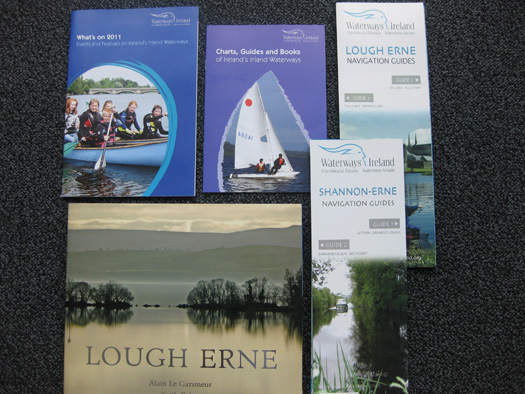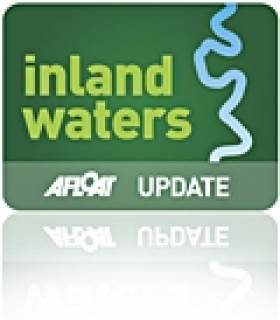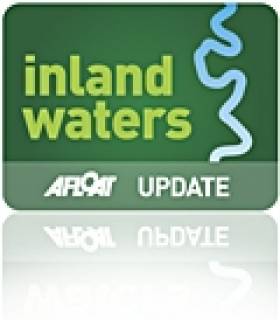Displaying items by tag: Shannon Erne Waterway
Notice: Inspection Of Lock Chambers & Weirs On Shannon Erne Waterway
#InlandWaterways - Waterways Ireland wishes to advise masters of vessels on the Shannon Erne Waterway that the inspection of lock chambers and weirs is presently underway and will be completed on Friday 1 March.
Masters approaching locks should be prepared to stop short and await instructions from the dive safety officer before proceeding.
Controlling The Canals
I wrote recently that the terms of Waterways Ireland's licence agreement for the "Extended Term Serviced Mooring Vacancies" at Shannon Harbour could be easily adapted for use elsewhere on the canals. That might allow WI to begin to bring the long-term berthers, residential or otherwise, under control. And so it proves. We have received this press release from Waterways Ireland.
WI Press Release
Waterways Ireland has recognised that many boat owners wish to stay for a more extended period in a single location than the 5 days the annual Canal Mooring and Passage Permit (under the Canals Act, 1986 (Bye-laws), 1988) currently allows.
In response, Waterways Ireland intends to issue an Extended Mooring Licence granting a boat owner the right to leave their boat in one location for longer than 5 days. This permit will enable the holder to moor in a position allocated by Waterways Ireland on a soft bank area of navigation property for a period of up to 1 year. The Extended Mooring Licence will cost e152 per annum.
The application process for the Extended Mooring Licence will open in the autumn when all existing permit holders will be contacted.
All boat owners will still require an annual Canal Mooring and Passage Permit allowing the holder to cruise and pass through locks. Boat owners with a Canal Mooring and Passage Permit proposing to stay longer in one location than 5 days can then apply for the Extended Mooring Licence. The total fee to hold both the Permit and the Licence in 2012/2013 will be e278.
For boat owners with the Canal Mooring and Passage Permit who do not hold an Extended Mooring Licence, the 5-day rule (in the one place or within 500m of that location) will still apply. Waterways Ireland will enforce this bye-law from autumn 2012.
Waterways Ireland will be contacting permit holders regularly between now and autumn 2012 to ensure they are kept up to date with the roll-out of the new permit. All queries about the enforcement of the current bye-laws or the Extended Mooring Licence should be directed to Shane Anderson, Assistant Inspector of Navigation: Tel no +353 (0)87 286 5726, Email [email protected].
These changes are necessary steps to improve the management of the canals and waterway amenities for both the navigational and recreational user, so that investment in the new infrastructure and facilities which Waterways Ireland has undertaken is maximised for every user.
Comment
About time too. I welcome this development: WI has to be able to control who uses its waterways and the uses they make of them.
The proposed charge is surprisingly modest. It is the same for all areas, those of high and of low demand: it might have been difficult to implement differential charging. However, the new licence does not apply to hard-edged areas; I presume therefore that WI intends to keep them clear for visitors.
It is significant that the new control mechanism is a licence, not a permit. Waterways Ireland had been hoping to bring in a single set of bye-laws to cover all its navigations, but it proved to be very difficult to do that within two jurisdictions. Accordingly, I understand that WI now intends to seek amendments to the bye-laws for the Republic, allowing it (inter alia) to increase the charges for various permits. However, the Canals Act 1986 allows WI to issue licences, and they are not subject to the restrictions in the bye-laws.
Royal water
The fragility of the water supply to the Royal Canal was shown in April, when Waterways Ireland closed the summit level of the canal because of low water levels; the 34th and 35th levels were also closed for emergency repairs. At time of writing, WI is hoping to be able to re-open the summit level on 1 June. Some boats that had intended to go west along the Royal to the Shannon were forced to go east instead, through Dublin and along the Grand Canal; happily, Effin Bridge, the lifting bridge at North Strand Road, worked properly this year.
The Royal always had fewer feeders than the Grand. The summit level was fed from Lough Owel, north of Mullingar, but while the canal was closed, Westmeath County Council found it needed more drinking water for the Mullingar area. In dry conditions, the Lough Owel feeder cannot meet both needs.
With great foresight, CIE (which then owned the canal) got the Council to agree that, if the canal was to be re-opened, it would provide an alternative supply.
Nowadays, environmental regulations mean that water abstraction needs more thought, more planning and more factors to be considered. Extensive studies were carried out and WI and the County Council agreed that the best possible alternative source was Lough Ennell, which is south of Mullingar: water could be pumped from there to the canal. The Council had to apply to An Bord Pleanála for permission; it has just completed oral hearings in Mullingar.
Traditional boats
In the first half of the nineteenth century, anyone travelling to the seaside resort of Kilkee could take the steamer to Kilrush and travel onward by road. But the passenger traffic was initially established by the turf boats of the Shannon Estuary: most of Limerick's fuel came from Poulnasherry, west of Kilrush, and was carried by small sailing boats, which also carried a few passengers.
A 24' replica of one of these boats was launched recently at Querrin, at the entrance to Poulnasherry. The Sally O'Keeffe was built by the Seol Sionna group http://seolsionna.org/, which grew out of the West Clare Currach Club. The boat will be used for sailing training. The Shannon Estuary, which is insufficiently appreciated, has a wealth of traditional boat types, but there were no extant Shannon hookers, so it is nice to see their return.
On the same weekend, another of those traditional boat types was featured in Limerick. The Ilen Wooden Boat Building School http://ilen.ie/gandelow-races/ had built five gandelows, boats used in the upper reaches of the estuary, and conducted races in the city.
And the Thomastown Regatta, on the Nore http://www.happyvalleyfestival.com/ebooklet.pdf, will feature traditional cots and racing boats: the 1905 racing cot Nore Lass, owned by the O'Farrell family, will be on display at the Grennan Mill Craft School.
Here are some updates I wrote about recently...
Water charges
The EU Commission sent a Reasoned Opinion to Ireland in November 2011, suggesting that Ireland had not correctly implemented the provisions of the Water Framework Directive that require "a cost recovery policy for water services that includes the environmental and resource costs of water use". The Commission believes that cost recovery should be extended to many other water uses, including hydroelectricity generation and the supply of water to navigations. Having got an extension of the deadline for replying, the Department of the Environment, Community and Local Government responded to the Commission. I asked for a copy of the response, but the department won't tell anybody what it's doing. I am appealing that decision, but without much hope.
Traffic
Waterways Ireland has kindly given me the Shannon traffic figures for the first four months of 2012. The numbers of movements in those months are always low, and can be significantly affected by the weather, so there can be quite a lot of variation between one year and another without its indicating any long-term trend. For example, back in 2002, there were 4875 boat movements in the first four months; the figure was up to 6204 in 2003 but back down to 5304 in 2004. It's important therefore not to read too much into the figures, but a five-year moving average suggests that traffic has been falling since 2007. The figure for 2012 was 4052. It will be interesting to see whether better weather balances economic gloom in the rest of the year.
Mineral Oil Tax
In the last issue, I gave the figures for the numbers of Mineral Oil Tax returns received by Revenue from owners of diesel-powered boats in the first two years of the scheme's operation. They told me that they got 38 returns in 2010 for the year 2009 and 41 in 2011 for 2010. I now have the figure for the following year, the returns made in 2012 for the year 2011. There was a very significant change, of 46%, but unfortunately it was downward, to 22. The Revenue Commissioners tell me that "[...] there were 22 returns received by 1 March 2012 for 2011, amounting to e53,398.58 MOT [Mineral Oil Tax] on 141,503.29 litres oil." That's an average of 6432.1 litres each, which is a lot, so I suspect that much of the total came from the hire fleet, with less than twenty private owners making returns.
Royal and Ulster Canals
I said, in the last issue, that I did not understand how the cost of the restoration of the Royal Canal, 146 km with 46 locks, could be less than the expected cost of the canal to Clones, 13 km with one double lock. It has been explained to me that the figure for the Royal was essentially only the marginal cost, recorded (initially) under Civil Service accounting procedures, so that it understates the total cost. It would be a huge job to try to find the full cost using modern accounting conventions, but unfortunately that means that we have no usable figure for the cost of the Royal, no basis for estimating the return on investment and no guideline on the value of any future restorations.
Waterways Ireland Release New Guides to the Waterways
The Shannon-Erne Waterways Charts have been updated to take account of the upgrade works that have taken place in recent years along the navigation. The revision of the navigation guides for Lough Erne have been facilitated by the survey work undertaken recently on the lakes by Waterways Ireland in joint partnership with OSNI. Staff from Operations and the Inspectorate have also been closely involved in the revisions. The price of the new guides remains unchanged.

The new inland waterways publications
The Whats On 2011 is a free guide to all the events taking place along the waterway corridors in 2011. The Publications Catalogue (free) highlights the publications Waterways Ireland has for sale and for free with Navigation, History and Activity sections covering a wide range of interests. A photographic book for Lough Erne has just been published and is also for sale through Waterways Ireland.
All the publications are available from the Waterways Ireland webshop www.shopwaterwaysireland.org or from retailers, hospitality outlets and Tourist Information Centres along the navigations.
Warning - Snow Bound Harbours Pose Major Risk
Snow bound harbours and ice covered jetties in particular are dangerous to walk on or near because of the risk of slipping, tripping or falling near to the water's edge.
Sections of the Royal and Grand Canals and the Shannon Erne Waterway have restricted navigation due to ice accumulation.
Where water in lock chambers has frozen the public is warned not to attempt to cross over a lock in this state due to the great danger of ice cracking underfoot and being drowned in the lock.































































